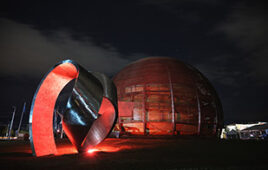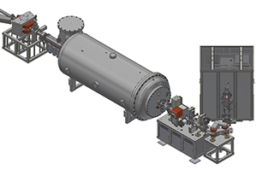An international team of scientists, led by a team at Monash Univ.,
has found the key to the hydrogen economy could come from a very simple
mineral, commonly seen as a black stain on rocks.
Their findings, developed with the assistance of researchers at UC Davis in
the USA
and using the facilities at the Australian Synchrotron, was published in the
journal Nature Chemistry.
Professor Leone Spiccia from the School
of Chemistry at Monash Univ.
said the ultimate goal of researchers in this area is to create a cheap,
efficient way to split water, powered by sunlight, which would open up
production of hydrogen as a clean fuel, and leading to long-term solutions for
our renewable energy crisis.
To achieve this, they have been studying complex catalysts designed to mimic
the catalysts plants use to split water with sunlight. But the new study shows
that there might be much simpler alternatives to hand.
“The hardest part about turning water into fuel is splitting water into
hydrogen and oxygen, but the team at Monash seems to have uncovered the
process, developing a water-splitting cell based on a manganese-based
catalyst,” Professor Spiccia said.
“Birnessite, it turns out, is what does the work. Like other elements
in the middle of the Periodic Table, manganese can exist in a number of what
chemists call oxidation states. These correspond to the number of oxygen atoms
with which a metal atom could be combined,” Professor Spiccia said.
“When an electrical voltage is applied to the cell, it splits water into
hydrogen and oxygen and when the researchers carefully examined the catalyst as
it was working, using advanced spectroscopic methods they found that it had
decomposed into a much simpler material called birnessite, well-known to geologists
as a black stain on many rocks.”
The manganese in the catalyst cycles between two oxidation states. First,
the voltage is applied to oxidize from the manganese-II state to manganese-IV
state in birnessite. Then in sunlight, birnessite goes back to the manganese-II State.
This cycling process is responsible for the oxidation of water to produce
oxygen gas, protons, and electrons.
Co-author on the research paper was Dr Rosalie Hocking, Research Fellow in
the Australian Centre for Electromaterials Science who explained that what was
interesting was the operation of the catalyst, which follows closely natures
biogeochemical cycling of manganese in the oceans.
“This may provide important insights into the evolution of Nature’s
water splitting catalyst found in all plants which uses manganese centers,” Dr
Hocking said.
“Scientists have put huge efforts into making very complicated manganese
molecules to copy plants, but it turns out that they convert to a very common
material found in the Earth, a material sufficiently robust to survive tough
use.”
The reaction has two steps. First, two molecules of water are oxidized to
form one molecule of oxygen gas (O2), four positively-charged
hydrogen nuclei (protons) and four electrons. Second, the protons and electrons
combine to form two molecules of hydrogen gas (H2).
The experimental work was conducted using state-of-the art equipment at
three major facilities including the Australian Synchrotron, the Australian
National Beam-line Facility in Japan
and the Monash Centre for Electron Microscopy, and involved collaboration with
Professor Bill Casey, a geochemist at UC Davis.
“The research highlights the insight obtainable from the synchrotron based
spectroscopic techniques—without them the important discovery linking common
earth materials to water oxidation catalysts would not have been made,” Dr
Hocking said.
It is hoped the research will ultimately lead to the development of cheaper
devices, which produce hydrogen.




